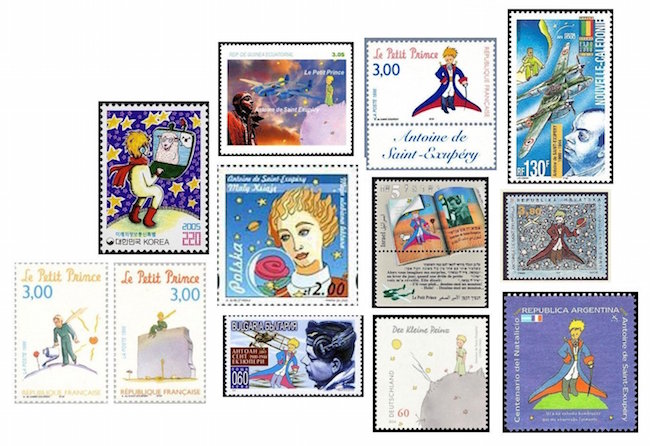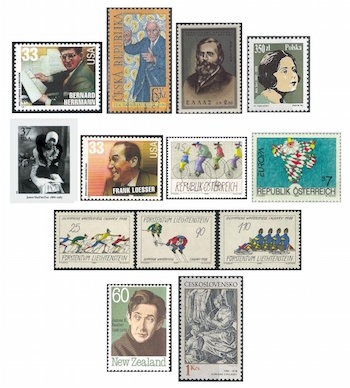The Arts on Stamps of the World — June 29
An Arts Fuse regular feature: the arts on stamps of the world.

By Doug Briscoe
June 29 is the birthday of Antoine de Saint-Exupéry, Bernard Herrmann, and Rafael Kubelík. But we begin with an important figure in the Romantic movement.
Italian poet Giacomo Leopardi (Giacomo Taldegardo Francesco di Sales Saverio Pietro Leopardi, to give him his full due) was born on this day in 1798 and grew up in a stifling home environment in an isolated village in what was then the Papal Marches. Moreover he suffered from a form of bone disease, likely arthritis or perhaps tuberculosis of the vertebrae. He sought solace in voracious reading, learning Latin, Greek, Hebrew, French, Spanish, and English along the way. His natural inclination was to emulate these models in poetry of his own, and he wrote in profusion from an early age. Leopardi found an outlet for his gifts with the friendship of the writer and classical scholar Pietro Giordani, first through correspondence, then through recurring personal contact. Among his works of this period are a translation of Book II of the Aeneid and a Hymn to Neptune composed in classical Greek and mistaken by some as a work of the ancients. In the ensuing years Leopardi was able to live in various Italian cities, writing prolifically but hampered by his poor health. He died on June 14, 1837, just two weeks shy of his 39th birthday. His influence on literature is well beyond what might be expected from his circumscribed existence. Just three years ago the Italian biopic Leopardi (original Italian title: Il giovane favoloso), directed by Mario Martone, was released.
The French aviator and writer Antoine de Saint-Exupéry (1900 – 31 July 1944) is the author of the beloved novella The Little Prince, which has been adapted for ballet and opera more times than you might suspect. Besides Rachel Portman’s 2003 opera, there are operatic treatments by Michael Horwath (1985) and Nikolaus Schapfl (also 2003) and several musicals, along with a symphony from 1962 by the Russian composer Lev Knipper. Of the half-dozen (!) ballet adaptations, the most recent, from just two years ago, was presented by the National Ballet of Canada of Toronto, with music by Kevin Lau (and libretto by Adam Gopnik, no less!). If the number of musical treatments of The Little Prince is surprising, the number of worldwide stamps honoring Saint-Exupéry and his creation is little short of astonishing. I was able to find a dozen colorful stamps for Le petit prince alone, not to mention seven stamps celebrating its author. The aviation aspect of his life is reflected in particular in two works, Night Flight (1931) and Wind, Sand and Stars (1939). While flying with the Free French Air Force during World War II, Saint-Exupéry disappeared over the Mediterranean in July 1944. The aircraft was discovered in 2000, its identity confirmed in 2004.

Bernard Herrmann (1911 – 24 December 1975) began life as Max Herman in New York City. He is best known to us as a composer of famous film scores, but his early life is also of considerable interest. At thirteen he won a prize for composition and decided to commit himself to music. He worked at CBS in the 30s, eventually becoming chief conductor of the CBS Symphony Orchestra. Wikipedia says, “He was responsible for introducing more new works to US audiences than any other conductor — he was a particular champion of Charles Ives’ music, which was virtually unknown at that time.” At CBS he met Orson Welles and went on to write the scores for both Citizen Kane and The Magnificent Ambersons. Between those two films came The Devil and Daniel Webster, for which Herrmann won his only Oscar (1941), though he was nominated for Citizen Kane and others. Among his seven film scores for Alfred Hitchcock are, most famously, those for Vertigo, North by Northwest, and Psycho. His other film work included The Ghost and Mrs. Muir (1947), The Day the Earth Stood Still (1951), The Man in the Gray Flannel Suit (1956), Journey to the Center of the Earth (1959), Fahrenheit 451 (1966), and his final score, Taxi Driver (1976). In addition, Herrmann composed works for the concert hall, including a fine symphony (1941).
Czech conductor Rafael Kubelík’s father was the violinist Jan Kubelík (we’ll be seeing his stamp in just a few days on July 5), and his mother was a countess. He was tolerated as principal conductor of the Czech Philharmonic under the Nazi regime even though he refused to conduct Wagner during the war. In 1944 he felt it prudent to go into hiding in the countryside to avoid the Gestapo. When the Communists took over the country in 1948 he defected to Britain, feeling that having lived under one dictatorship was enough. In happier years he became music director of the Chicago Symphony Orchestra (1950–53), the Royal Opera, Covent Garden (1955–58), and the Bavarian Radio Symphony Orchestra (1961–79). He made many very fine recordings. After his first wife died as the result of an automobile accident, he married the Australian soprano Elsie Morison (who turns 93 on August 15). Kubelík was also a composer, his works including five operas, three requiem settings, three symphonies, and six string quartets. Born 103 years ago today, Rafael Kubelík died on 11 August 1996.
Called the “father of Greek seascape painting”, Konstantinos Volanakis, born in 1837 in Heraklion, came fortuitously to his calling. Working as an accountant in Trieste, he would sketch boats and harbor scenes in his account books. Rather than upbraiding him, his employers, with remarkable generosity, arranged for him to study art in Munich, where at first he painted portraits. In 1869 he won a drawing contest on the subject of The Battle of Lissa, which came with a handsome monetary prize and free travel with the Austrian navy for three years. Many sketches and paintings resulted from these journeys. Volanakis, whose precise date of birth remains unknown, died on this date in 1907, a hundred and ten years ago today.

Ada Sari (29 June 1886 – 12 July 1968) was a leading Polish soprano. Born Jadwiga Szayer (yahd-VEE-ga SHY-er), she studied in Cieszyn, Kraków, Vienna, and Milan before making her debut in Rome as Marguerite (Gounod’s Faust) in 1909. In the succeeding years she performed throughout Italy, and sang under both Mascagni and Leoncavallo (Cav and Pag) in Alexandria. Her subsequent appearances were largely limited to Eastern Europe until the end of World War I, when she went to South America, where she would perform often in the years to come, and made a tour of North America in 1921. She moved back to Warsaw in 1934, directed an underground opera studio during the Second War, and after the retirement from the stage in 1947, devoted many years to teaching.
African-American photographer James Van DerZee (June 29, 1886 – May 15, 1983) was a pioneer at capturing images of black New Yorkers during the Harlem Renaissance. His sister, who went by the name Madame E. Toussaint Welcome, was one of the first black women to work as a filmmaker. They were both born in Lenox, Massachusetts, where James began taking photographs in childhood and developing them in his own makeshift darkroom. He was nineteen when he went to Harlem with his father and brother and set up his studio in his sister’s Toussaint Conservatory of Art and Music. Van DerZee made thousands of photos, including some portraits of well known figures like Joe Louis and Marcus Garvey. The 2002 stamp from a sheet honoring American photographers shows “My Corsage”.

One day after Richard Rodgers’s birthday we have another Broadway songwriter whose stamp comes from the same set (so does the Herrmann stamp), Frank Loesser (June 29, 1910 – July 28, 1969). Though not quite an EGOT winner like Rodgers, he did get 75% of the way there: several Tonys, a Grammy, and an Oscar (for the song “Baby, It’s Cold Outside” from the 1949 musical Neptune’s Daughter) graced his mantelpiece. Too, he shared a Pulitzer with Abe Burrows for How to Succeed in Business Without Really Trying. He also collaborated with Burrows on Guys and Dolls, for which Loesser wrote all the music and lyrics, with Burrows sharing the book credit with Jo Swerling. An out-of-the-way bit of trivia is that Loesser’s half-brother Arthur formed a piano duo with Canadian conductor Wilfrid Pelletier, whose birthday was the 20th (no stamp). Another classical music connection is that Loesser’s first published lyric, “In Love with the Memory of You”, was set to music by William Schuman. Loesser wrote the lyrics for 700 songs, including “Heart and Soul” (1938), “Praise the Lord and Pass the Ammunition” (1942), and “On a Slow Boat to China” (1948).
Austrian illustrator, graphic artist, caricaturist, and, yes, stamp designer Paul Flora (1922 – 15 May 2009) made a specialty of ink line drawings and worked for Britain’s Times and Observer newspapers as well as for Die Zeit. He had many exhibitions of his work for over half a century from 1947 to 2002. You can look at examples of his work, some of it quite reminiscent of Edward Gorey (like this one, “Ball Game”), on his Website. Or you can just look at a few of his stamp designs right here: a whimsical one for carnival season, 1985, and a Flying Harlequin on a 1993 stamp, both of these for his native Austria, and a set of three Liechtenstein stamps for the Winter Olympics of 1988.
New Zealand poet James K. Baxter (29 June 1926 – 22 October 1972) published his first book at seventeen, and it was very well received. Something of a misfit, Baxter did not complete his university education, worked odd jobs, and took to alcohol. Nevertheless his output was prodigious. There are more than two dozen books of poetry, some plays, and a posthumously published novel. Baxter was critical of modern society and its institutions, and relied on a faith that moved from Anglicanism to Catholicism, but he admired the cultures of India and of the Maoris. When he died at 46, after years of neglecting his health, the burial service combined elements of both Catholic and Maori religious practice.
Finally, I will mention the Flemish designer and engraver Adriaen Collaert, who died on this date in 1618 (born c1560). One of his engravings is the lovely musical one shown at lower right. This is a detail from a larger work I haven’t been able to identify.
Honorable mention today goes to American poet and story writer Celia Thaxter (June 29, 1835 – August 25, 1894), American singer and actor Nelson Eddy (1901 – March 6, 1967), who doesn’t get a stamp even though Jeanette MacDonald [6/18] did, and the fine Scottish character actor Ian Bannen (1928 – 3 November 1999).
A graduate of the University of Massachusetts with a B.A. in English, Doug Briscoe worked in Boston classical music radio, at WCRB, WGBH, and WBUR, for about 25 years, beginning in 1977. He has the curious distinction of having succeeded Robert J. Lurtsema twice, first as host of WGBH’s weekday morning classical music program in 1993, then as host of the weekend program when Robert J.’s health failed in 2000. Doug also wrote liner notes for several of the late Gunther Schuller’s GM Recordings releases as well as program notes for the Boston Classical Orchestra. For the past few years he’s been posting a Facebook “blog” of classical music on stamps of the world, which has now been expanded to encompass all the arts for The Arts Fuse.
